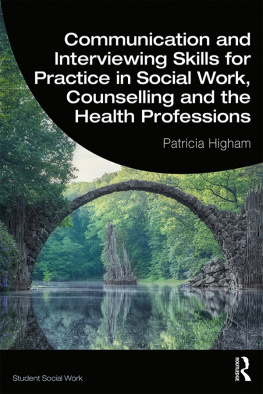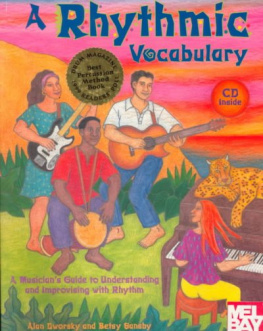RHYTHM
TO
RECOVERY
A Practical Guide to Using Rhythmic Music, Voice and Movement for Social and Emotional Development
Simon Faulkner
Foreword by Dr James Oshinsky, PhD

Jessica Kingsley
Publishers London and Philadelphia
CONTENTS
FOREWORD
When Simon Faulkner asked me to write a foreword for his book on the use of drumming and other forms of rhythmic music and movement for promoting social-emotional learning, I was flattered and excited. He and I belong to a somewhat small fraternity of dual-credentialed folk who are both professional therapists/counsellors and at least amateur musicians, operating outside the boundaries of traditional clinical music therapy. We have seen first hand the powerful and transformative influences of group music making on populations that historically have been considered hard to reach. We have put in the time trying out variations on talk-based groups and education-based programs, and we know both the value and the limitations of these approaches.
Therapists and educators have always known that lived experience is a more powerful teaching method for social skills than even the best word-based lessons. It is not hard to create lessons that contain pro-social content. But clients low in social awareness or motivation can act as if they had internalised empathy or assertiveness that have not truly rooted. Our personal stories, when told in words, require exposure that overtaxes modest levels of group trust. So clients, out of self-preservation, risk less or conform superficially. This does not lead to healing or lasting change.
What has been needed is a method that provides vivid experiences through which clients can feel their place in a group, experiment with social limits in a safe manner and take risks to discover their personal identity. Drumming and other forms of rhythmic exercises are effective as mediums for social interaction and growth because they are first and foremost inherently enjoyable, and because the level of coordinated listening, observing and responding is immediately apparent. The feedback loop between participation and evaluation is immediate, visceral and wordless. This is powerful body memory learning, like riding a bicycle.
People who have not yet had the experience of drumming in a group or who have never played other forms of transcendent improvised music may doubt the impact of such an apparently simple activity on social awareness or personal identity. Many among us have accepted unfortunate cultural messages that music is for experts or that music is for performance and entertainment, leaving our participation in group music limited to singing Happy Birthday and our various national anthems. But tribal societies value music in ways we might emulate for our own benefit. Every drumming gathering metaphorically creates its own tribe, with group membership quickly accessible through a willingness to join in. Once we have taken a seat in the circle, we have many ways to affirm our relationship to the group. We can play parts modelled by others and we can use our body intelligence to feel the pulse of the rhythms and play along with the pulse as we experience it. We will discover whether our experience is conventional, common and confirmed by our peers, or whether we truly march to a different drummer and perceive the music in unconventional ways. This feedback will influence our playing, so that a social transformation may occur entirely unconsciously.
But if community drumming experiences were only useful for becoming better musicians, drumming would be of less interest to therapists and counsellors. The powerful social lessons of drumming can be translated into verbal metaphors that apply to social interactions in wide areas of life having nothing to do with music. This is the great achievement that Simon Faulkner is sharing with us; he has honed the language to its essentials, and he presents us with an elegant and orderly entre into this integrated world, where un-reflected musical experience meets the verbal messages that permit the generalisation of social lessons into the whole fabric of a persons life. A drummer who learns to play more unselfishly becomes a more unselfish person. A drummer who learns that his or her drumming has an important place in the groups overall sound grows in self-worth. A drummer who finds an outlet for his or her painful life experiences in music has less need to harbour these pains or inflict them on others. These kinds of transformational statements are all supported by years of careful research that was either pioneered or inspired by Simon Faulkner. His talents as an educator make his descriptions of this work transparently clear. His experience as a counsellor helps him patiently sequence the material to build from foundations of trust to higher levels of risk and exposure. And having been a musician who started from humble beginnings, he knows how to make the physical coordination demands of the drumming gentle enough to be inclusive and broad enough to accommodate players whose virtuosity can shine.
In a thorough and insightful way, using the highly engaging medium of community drumming, Simon Faulkner has created in Rhythm2Recovery a sequenced model for imparting social awareness to a variety of populations not readily reached by more common counselling methods. His activities are simple to understand, meticulously researched and powerfully impactful in lasting ways. It is my sincere hope that readers put aside any preconceived notions they may have about drumming being a trivial, disorderly or superficial use of therapy time. What the open-minded reader will find is that drumming can provide a cocoon of safety in which participants can viscerally feel their place of belonging in a group. Rhythm2Recovery uses the best elements of experiential learning to help clients discover what it means to support others with a beat, rhythm or groove and learn the lessons of trust that accompany providing and receiving support. They can experiment with how much of their identity to reveal in a group through their willingness to use solo opportunities, which can take place first through the wordless medium of music and later can be matched with a personal verbal narrative.
As author, Simon has conducted an orchestra, blending the accumulated wisdom of cognitive verbal methodologies with the disarmingly engaging, experiential, non-verbal activities afforded by drumming. The success of this model is proving the quality of his work in a growing number of international settings. Grab a drum, read this book, sit in the circle with him and be amazed at the profoundness of what you painlessly learn about yourself and can impart to others.
Dr James Oshinsky, PhD
James is a psychologist and musician. He teaches both psychology and music improvisation courses at Adelphi University in Garden City, NY (USA). He is the author of Return to Child , a book about improvisational music making on all instruments and how to teach improvisation. Dr Oshinsky is on the teaching staff of Music for People, an organisation that has been offering improvisation workshops to the public for 30 years.
INTRODUCTION
In 2002, I was working in a small, community high school, in a regional town in the Wheatbelt region of Western Australia, as a member of the local drug and alcohol support service. My work as a counsellor was targeted at young people with a known history of drug use, criminal behaviour or other risk factors such as family dysfunction or homelessness. A good proportion of those chosen by the school for my groups were local Australian Aboriginal children. Being schooled in a cognitive approach my practice centred on trying to build a trusting relationship with those I worked with and engage them in discussing their thoughts, feelings, behaviours and any other issues that impacted their risk of being drawn into the problematic world of addiction. It was difficult, disheartening work and the level of engagement was often very low, because for these young people naming and then talking about such personal issues was both difficult, painful and confronting.
Next page









